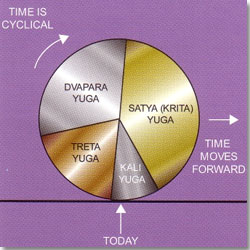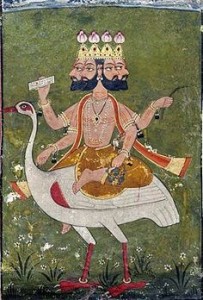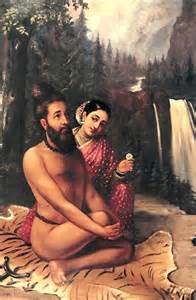
Hinduism perceives time to flow in great cycles called yugas. Time is circular. There are four yugas and depending upon the yuga the duration varies. The four yugas along with their duration in earthly years are:
Satya Yuga 1,728,000
Treta Yuga 1,296,000
Dvapara Yuga 864,000
Kali Yuga 432,000
__________
Total 4,320,000 One yuga cycle.
I say earthly years because Hindu scripture gives the years as divine years–time according to the calculation of the Gods. Notice that the basic number is 432,000, the age of Kali yuga, and so dvapara is twice that number, treta is 3 times that number and satya is four times that number. One rotation of these four yugas is called a yuga cycle which is a total of 4,320,000 years. A thousand yuga cycles is called a kalpa and therefore a kalpa is 4,320,000,000 years. Time moves on in these great cycles, yuga after yuga, kalpa after kalpa, eternally.
To give an example how such huge numbers are used, consider the lifetime of Brahma, the four headed creator God. Brahma’s life span is calculated according to yuga time. One kalpa is said to be the 12 hours of Brahma’s day, so his 24 hour day is two kalpas in length. That means 24 hours of Brahma’s time is 8,640,000,000 earthly years! His year is 365 days long and he lives for a 100 years. I leave it to my readers to do the math. My calculator does not have enough places to calculate the vast lifetime of Brahma. I am amazed by the size of the numbers that the early Hindu thinkers were dealing with.
Now consider the story of one hairy sage. This is a story taken from one of the Puranas. A hairy sage once showed up in the court of King Indra and when asked where he lived the sage replied that since life was so short he had decided not to marry and so did not to have a home. Indra then asked him why he had such a strange bald spot on his chest where hair was obviously falling out. The sage replied that each time a Brahma died he lost one hair from his chest and this why he has becoming bald. The sage further asserted that once he had lost all of this hair from the death of so many Brahma’s he too would die. And you can be sure he was a very hairy sage! Add to this the idea that within Hinduism there is not just one universe, but endless numbers of universes all with their own Brahmas that come and go like moths rushing into a fire and you get a sense of time within Hinduism. These anecdotes give us an understanding of the massive time frames in which the Hindu mind has conceived of time. Compare this with the Biblical story of Genesis where God created the world in seven days and you see the different conceptions of time between the two cultures.

It is said that we are now living within the Kali yuga, which started about 5000 years ago. Each of these yugas is said to have a certain quality of life. Kali yuga is the worst of times because it is the time of quarrel and deceit. The level of morality and spirituality is greatly decreased and the maximum span of life one can expect is only 100 years. In the previous yuga, Dvapara Yuga, life is said to have been much better. The lifetime of a human being during the Dvapara Yuga could be as much as 1000 years. Life was more vibrant and spirituality was greatly increased. It is described how a human being stood as much as 12 feet tall and how the trees and animals are much larger as well. The Treta yuga was an even better time with the maximum life span as much 10,000 years. Spirituality is even higher, and finally, in the best of times, the Satya Yuga the life of a human being could be up to 100,000 years! The Mahabharata and the Puranas are full of stories from the various yugas describing scenes of people living for huge periods of time. The great sage Vishwamitra, for example, mediated in water for 60,000 years before his meditation was broken by the beautiful Menaka. Their union brought about the famous Shakuntala, the heroin of many famous stories and plays in Sanskrit. Similarly, in many of thePuranas, ten avataras of Vishnu are said to repeatedly appear throughout the yuga cycles. Rama always appears during the Treta Yuga, Krishna appears at the end of Dvapara, and Kalki, the final avatara comes at the end of Kali Yuga to destroy all things and prepare the way for the next Satya Yuga. There are, therefore, many appearances of Rama, Krishna, and the other avataras. This is all takes place within the great cycles of yugatime.